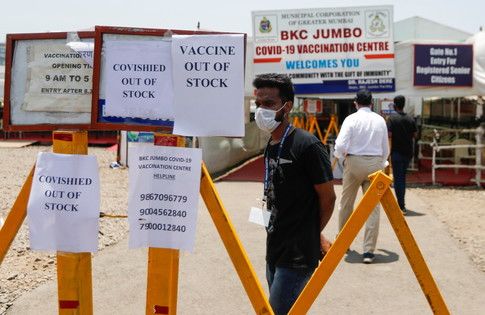There’s a chance the submarine fell to a depth of over 2000 feet.



In this episode of “Intelligence Matters,” National Security Commission on Artificial Intelligence Chair and Former CEO of Google Eric Schmidt joins Michael Morell to discuss the importance of investing in artificial intelligence as a national security priority. Schmidt believes China is likely to catch up to the U.S. in a few years in its artificial intelligence capabilities. He outlines how intelligence and national defense can benefit from superiority in these technologies and the benefits of holding A.I. to American values.
HIGHLIGHTS
China is catching up to the U.S. in A.I. capabilities: “Where we are today with A.I. is that we judge America still ahead, but China investing very heavily and likely to catch up very soon. We don’t say what soon is, but my personal opinion, it is a few years, not five years.”

British prime minister Boris Johnson has cancelled his trip to India, with the country being added to the UK’s “red list” of restricted destinations. COVID-19 cases in India are rising sharply and a specific variant of the virus – B1617 – is becoming increasingly common there.
The views expressed in this article are those of the author alone and not the World Economic Forum.

Reinforcement learning algorithms are only now starting to be applied in business settings — but could help companies solve complicated problems. Here’s how.
Most machine learning systems leverage historical data to make predictions. But learning through trial and error lead to more creative solutions.

Researchers at the National Institute of Standards and Technology are proposing a new approach to large-scale artificial intelligence (AI) by relying on the integration of photonic components with superconducting electronics.
Previous approaches to achieving general intelligence in artificial intelligence systems have focused on conventional silicon microelectronics paired with light. There are major barriers to this approach, however. There are many physical and practical limitations with the fabrication of silicon chips with electronic and photonic elements.
General intelligence is “the ability to assimilate knowledge across content categories and to use that information to form a coherent representation of the world.” It involves the integration of various sources of information, and it must result in a coherent and adaptive model of the world. The design and hardware construction for general intelligence requires the application of principles of neuroscience and very-large-scale integration.

DAYTONA BEACH, Fla. — An anonymous donor has made it easier for dogs at the Halifax Humane Society to find a forever home thanks to a cryptocurrency investment.
Halifax Humane Society Community Outreach Director Barry Kukes said the woman stopped by the shelter Saturday and paid all the adoption fees for dogs ready to be adopted out.
“Basically, had made a very wise investment in some cryptocurrency and had a windfall and said it changed her life that she wanted to do something nice,” he said.

Scientists have discovered one of the smallest black holes on record—and the closest one to Earth found to date.
Researchers have dubbed it ‘The Unicorn,’ in part because it is, so far, one of a kind, and in part because it was found in the constellation Monoceros—’The Unicorn.’ The findings are publishing today, April 21, in the journal Monthly Notices of the Royal Astronomical Society.
“When we looked at the data, this black hole—the Unicorn—just popped out,” said lead author Tharindu Jayasinghe, a doctoral student in astronomy at The Ohio State University and an Ohio State presidential fellow.

With NASA’s historic solar-powered helicopter flight over the barren slopes of Mars’ Jezero Crater, Leonardo da Vinci and Igor Sikorsky also deserve credit along with the Wright brothers for enabling this astounding bit of off-world powered, controlled flight. Da Vinci made one of the earliest drawings of a rotor-driven aircraft and Sikorsky built the U.S.’ first commercially viable helicopter.
Even though Orville and Wilbur Wright get credit for making the first powered, controlled aircraft flight at Kitty Hawk, North Carolina in 1903, the vertical flight of helicopters is markedly different. Thus, the first test flight of NASA’s Ingenuity helicopter is all the more astounding in no small part because Mars’ atmosphere is only one percent that of Earth.
“While these two iconic moments in aviation history may be separated by time and 173 million miles of space, they now will forever be linked,” NASA Associate Administrator for Science Thomas Zurbuchen said in a statement. “As an homage to the two innovative bicycle makers from Dayton, this first of many airfields on other worlds will now be known as Wright Brothers Field, in recognition of the ingenuity and innovation that continue to propel exploration.”
A company recently developed a novel system capable of printing biological tissue in a blindingly fast 30 seconds — creating a possible means of bringing an end to diabetes, according to a blog post shared on the Ecole Polytechnique Federale de Lausanne’s (EPFL’s) official website.
A bioprinted pancreas might remove the need for animal testing! Check out how diabetes might end.

The next version of Android remains focussed on developers until the first beta launches next month. With that in mind, we’re diving into today’s release of Android 12 DP3 to find all the new features.
Over the coming hours, we’ll dive into all of Android 12 DP3’s new features and every single change. (The newest updates will be at top of this list. Be sure to check back often and tell us what you find in the comments below.)
Google is planning eight releases over the coming months before the consumer launch later this year to Pixel phones and other devices. If you want to quickly install the Android 12 DP1 on your compatible Pixel 3, Pixel 3 XL, Pixel 3a, Pixel 3a XL, Pixel 4, Pixel 4 XL, Pixel 4a, Pixel 4a 5G, and Pixel 5 be sure to check out our step-by-step guide.